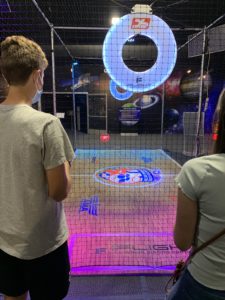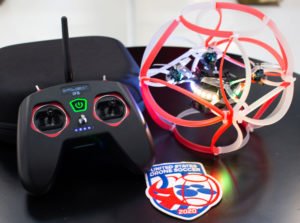
By: Dawn M.K. Zoldi, Guest Contributor
Drone soccer. It’s a thing. And it’s not just a sport that could be featured on ESPN 8, “The Ocho” (like Dodgeball). It’s an innovative way to inspire youth and the young-at-heart about STEM, specifically computer science and aerospace engineering, through thrilling team competition.
Kyle Sanders, V.P. of Education and Development for U.S. Drone Soccer, a graduate of the U.S. Air Force Academy and U.S. Air Force combat veteran/former instructor pilot, explains, “At U.S Drone Soccer, we combine sport and STEM education. Like with any traditional sport, academic and youth leagues attract a fan base and future players in the sport. But there’s a lot more to aerospace careers than just being a pilot. We want students to experience other skills that could lead to future careers.”
The sport itself began in South Korea and is now spreading across Europe. Sanders says he’s happy to lead adoption here in North America.
So, how does it work, exactly? Think Quiddich from Harry Potter. There’s a 10 x 20 foot indoor mesh arena to enclose the area of play and designed specifically to fit into a classroom. Two teams collide as they try to help their designated striker fly through the other teams’ goal. According to Sanders, “Drone soccer provides an accessible team environment for beginners that is a spectator-friendly and indoor-safe activity which schools can easily adopt without a FAA license. We feel like Drone Soccer is a great way to build the youth foundation now for drone sports and aviation career pipelines.”
Before the teams can fly, they have to first build and code. This is where the STEM aspect comes into play. As an intro to engineering, students take their kits and build their own Drone Soccer Ball. There’s no dangerous soldering or other specialized tools needed other than a screwdriver. Teachers and students get everything they need for success in the classroom. As for the drone itself, designed by U.S. Drone Soccer and produced by iFlight, it is an injection-molded exoskeleton that is rugged and durable. Most importantly, it’s forgiving for young pilots who can crash without spending a day at repairs. Sanders explains, “These things are built to knock into each other. Drone soccer is a full contact sport.”

Not only do students get to build and code the drone ball, they will also essentially be inventing new strategy and tactics for the sport. As an Air Force pilot, Sanders understands the importance of teamwork and communication. For Drone Soccer, those are yet to-be-determined. He explains, “To be honest, we’re not sure what team approaches will be successful in this sport. COVID paused world-wide competitions. We’re all just now forming teams and doing whatever small test events we can safely host. We’re excited to see what kind of formations and plays these new pilots come up with!”
Sanders’ mission is to make drone soccer accessible and welcoming. He reflects, “I found drone racing too difficult to get into. And I’m a professional pilot. I mean the hobby itself: what to buy, what’s compatible, where to race and a lack of a supportive community. Individual sports aren’t for everyone and I want team strategy. Drone soccer is a sport that a lot of drone pilots and newbies can really get excited about.”
While Drone Soccer’s aspirations are big, the cost of entry into classrooms and community venues is not. The Drone Soccer Ball will retail for about $180 alone, similar to other education drones like the DJI Tello. To provide a student everything he or she could possibly need including a toolkit, batteries, radio controller, and replacement parts, the entire package comes to less than $500 for a starter. Compared to similar robotics teams or traditional youth sports, this is a bargain.
Schools are budgeting for both classroom enrichment and practice arenas, as are museums and community-based drone venues who plan to host official Drone Soccer arenas. Semi-permanent practice arenas cost around $2500; a collapsible professional-grade arena runs about $10,000. The company is soon to release an automated scorekeeping system integrated into arenas. Venues with arena set-ups will be able to use Drone Soccer for visitor experiences, summer camps and be an accelerator in their communities for league events and tournaments.
U.S. Drone Soccer plans to roll out soon in select cities where enough schools are willing to adopt and form a league. As the company is headquartered in Colorado, it has leveraged its strong local partnerships for the initial launch. The Wings Over the Rockies Air and Space Museum in Denver will be the first venue to host an official Drone Soccer arena, scheduled to arrive later this month.
Beyond the national rollout this year, Sanders relates they are already working with Drone Soccer programs in other countries, most notably Spain, and are in the planning stages of international tournaments as soon as COVID allows. Sanders states, “We want to provide students with an obvious career pathway into aerospace with something they enjoy doing. To do this we have to offer educators a total solution right out of the box. As a natural extension of this success, we’re working hard to drive the adoption of youth drone sports, which will soon be the fan base for our international teams.”
Venues and school districts who want to help organize a program can reach out to Sanders and his colleagues at U.S. Drone Soccer directly and make plans for opening in August. They offer professional development for educators and everything needed to get started. Get ready to duck, dip, dive…and drone!
Miriam McNabb is the Editor-in-Chief of DRONELIFE and CEO of JobForDrones, a professional drone services marketplace, and a fascinated observer of the emerging drone industry and the regulatory environment for drones. Miriam has penned over 3,000 articles focused on the commercial drone space and is an international speaker and recognized figure in the industry. Miriam has a degree from the University of Chicago and over 20 years of experience in high tech sales and marketing for new technologies.
For drone industry consulting or writing, Email Miriam.
TWITTER:@spaldingbarker
Subscribe to DroneLife here.